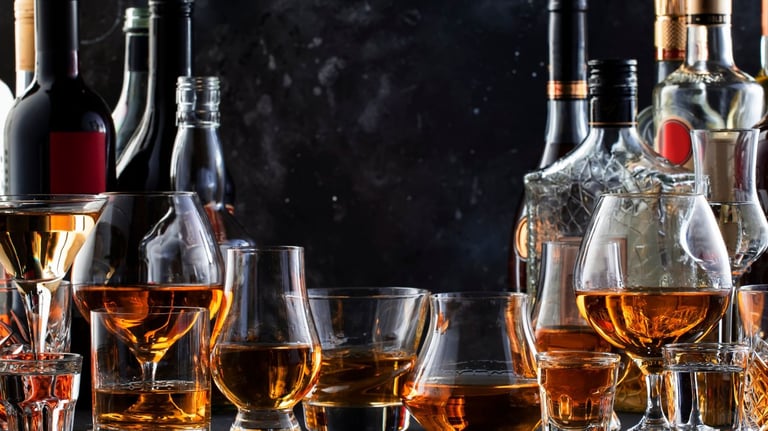
Fine Wine vs Spirits
Where to Invest in 2025?
1/23/2025


In the world of luxury investments, both fine wine and spirits offer compelling opportunities for collectors and investors alike. With increasing demand, limited supply, and a growing secondary market, both asset classes have demonstrated strong performance. However, understanding the unique characteristics of each is essential for building a well-rounded portfolio.
In this week’s WineLux edition, we explore the key differences between fine wine and spirits as investments, helping you decide where to place your bets in 2025.
Fine Wine vs Spirits: Key Differences in Investment Potential
While both fine wine and spirits can offer significant returns, they behave differently as investments. Here are the key distinctions:
1. Appreciation Over Time:
Fine Wine: Wine typically appreciates as it ages and becomes scarcer, especially if it improves in quality with time. The market value of rare and high-scoring wines, particularly from Bordeaux, Burgundy, and Napa Valley, often increases as these wines reach peak drinking windows. However, wine has a finite lifespan and must be consumed or sold before it passes its prime.
Spirits: Spirits like whisky and rum, on the other hand, don’t age once bottled, meaning their investment potential comes from their rarity and demand rather than improvement with age. Certain rare bottles of whisky from distilleries like Macallan or Japanese brands like Yamazaki have fetched record prices at auctions. Spirits tend to be more stable in value once bottled and can hold or increase their value over decades.
2. Liquidity and Market Dynamics:
Fine Wine: Wine has a well-established secondary market, particularly through platforms like Liv-ex and wine auctions. The demand for fine wine is global, with strong interest from Europe, Asia, and North America. The fine wine market is considered relatively liquid for high-quality, investment-grade bottles, but prices can fluctuate depending on the vintage, producer, and global trends.
Spirits: The market for collectible spirits, particularly rare whisky, is growing rapidly, especially in Asia. The secondary market is not as established as fine wine, but auctions for rare bottles are becoming more frequent. Liquidity in the spirits market is growing but can be slower compared to wine, depending on the rarity and brand recognition of the bottle.
3. Storage and Provenance:
Fine Wine: Wine requires precise storage conditions—temperature control, humidity, and minimal light exposure—to preserve its quality and value. Any deviation in these conditions can degrade the wine, impacting its market value. Provenance is critical; bottles with impeccable storage records command higher prices.
Spirits: Spirits are far easier to store. Once bottled, they are stable and don’t require temperature-controlled environments. This makes spirits less risky from a storage perspective. Provenance is still important for high-value spirits, but there is less concern about deterioration over time compared to wine.
Fine Wine: Why It’s Still a Top Investment in 2025
Despite the growing interest in spirits, fine wine remains one of the most attractive and proven luxury investments for 2025. Here’s why:
Proven Performance: Fine wine, particularly from regions like Burgundy, Bordeaux, and Napa Valley, has consistently demonstrated strong returns over the past two decades. Bordeaux First Growths, top Burgundies like Domaine de la Romanée-Conti, and Napa cult wines like Screaming Eagle are consistently high performers.
Global Demand: Fine wine appeals to a broad international market, with collectors from Asia, Europe, and the US driving demand for top vintages and rare bottles. The increasing interest in sustainability and biodynamic winemaking is also propelling the market forward, with consumers prioritising wines that reflect these values.
Investment Cycles: The fine wine market operates in cycles, with some wines experiencing peaks in value during prime drinking windows. This cyclical nature allows investors to time the market effectively, selling when wines are at their optimal value.
Spirits: A Growing Market for Collectors and Investors
The market for collectible spirits, particularly rare whisky, has exploded in recent years. Here’s why spirits are becoming an essential component of a luxury portfolio:
Scarcity and Prestige: The demand for rare whisky, particularly single malts from closed distilleries or limited-edition releases, has created a market where prices for collectible bottles can skyrocket. Brands like Macallan, Glenfiddich, and Japanese whiskies like Yamazaki and Hibiki are especially coveted.
Asian Market Influence: The rapid growth of high-net-worth individuals in Asia has driven demand for rare spirits, particularly whisky. In 2025, this trend is expected to continue, with auctions for limited-edition bottles and rare casks becoming more frequent in markets like Hong Kong and Singapore.
Long-Term Stability: Unlike wine, which has a peak drinking window, spirits do not degrade over time once bottled. This makes them a stable, long-term investment. Rare spirits tend to appreciate in value steadily as they become scarcer, particularly when distilleries release limited editions or vintage bottles.
Where Should You Invest in 2025?
Both fine wine and spirits have strong cases as investment assets in 2025. For the savvy collector, the best strategy may be to invest in both, leveraging the unique strengths of each:
For Long-Term Growth: Fine wine, particularly from established regions and producers, continues to offer strong returns, especially as global demand for top vintages rises. If you’re looking for an asset that appreciates over time with strong secondary market potential, wine remains a top choice.
For Stability and Scarcity: Spirits, particularly rare whisky, offer a level of stability that’s attractive to investors seeking low-maintenance assets. As the market for collectible spirits grows, rare bottles and limited releases are likely to see significant appreciation, especially in Asia.
By diversifying between fine wine and spirits, you can build a portfolio that balances the appreciation potential of wine with the long-term stability and scarcity of spirits.
Conclusion: Diversify Your Luxury Investment Portfolio
Fine wine and spirits both offer exceptional opportunities for collectors and investors in 2025. While fine wine remains a proven performer, the spirits market is rapidly growing, driven by demand for rare and collectible bottles. By understanding the strengths of each asset class, you can build a diversified portfolio that offers both growth and stability.

